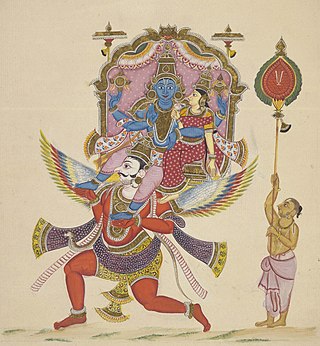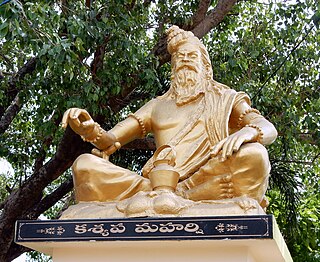
In Hinduism, Daksha is one of the prajapati, the agents of creation, as well as a divine king-rishi. His iconography depicts him as a man with a stocky body and a handsome face or the head of a goat.

Kurma, is the second avatar of the Hindu preserver deity, Vishnu. Originating in Vedic literature such as the Yajurveda as being synonymous with the Saptarishi called Kashyapa, Kurma is most commonly associated in post-Vedic literature such as the Puranas. He prominently appears in the legend of the churning of the Ocean of Milk, referred to as the Samudra Manthana. Along with being synonymous with Akupara, the World-Turtle supporting the Earth, Kurma is listed as the second of the Dashavatara, which are the ten principal incarnations of Vishnu.

Virabhadra, also rendered Veerabhadra, Veerabathira, and Veerabathiran, is a fierce form of the Hindu god Shiva. He is created by the wrath of Shiva, when the deity hurls a lock of his matted hair upon the ground, upon hearing of the self-immolation of his consort, Sati, at the Daksha yajna.
Manu is a term found with various meanings in Hinduism. In early texts, it refers to the archetypal man, or to the first man. The Sanskrit term for 'human', मनुष्य or मानव means 'of Manu' or 'children of Manu'. In later texts, Manu is the title or name of fourteen rulers of earth, or alternatively as the head of dynasties that begin with each cyclic kalpa (aeon) when the universe is born anew. The title of the text Manusmriti uses this term as a prefix, but refers to the first Manu – Svayambhuva, the spiritual son of Brahma. In the Hindu cosmology, each kalpa consists of fourteen Manvantaras, and each Manvantara is headed by a different Manu. The current universe, is asserted to be ruled by the 7th Manu named Vaivasvata. Vaivasvata was the king of Dravida before the great flood. He was warned of the flood by the Matsya (fish) avatar of Vishnu, and built a boat that carried the Vedas, Manu's family and the seven sages to safety, helped by Matsya. The tale is repeated with variations in other texts, including the Mahabharata and a few other Puranas. It is similar to other floods such as those associated with Gilgamesh and Noah.

The Shrivatsa is an ancient symbol, considered auspicious in Hinduism and other Indian religious traditions. It is said that the Shrivatsa symbol appears on the chest of an avatar of Vishnu when he is chosen to be Vishnu's incarnation

The Saptarshi are the seven seers of ancient India who are extolled in the Vedas, and other Hindu literature such as the Skanda Purana. The Vedic Samhitas never enumerate these rishis by name, although later Vedic texts such as the Brahmanas and Upanisads do so.

Lakshmi Narayana or Lakshmi Narayan is the dual representation of the Hindu deities Vishnu, also known as Narayana, and his consort, Lakshmi, traditionally featured in their abode, Vaikuntha. The goddess of prosperity and beauty, Lakshmi, is depicted as standing next to Vishnu, who holds the Panchajanya, Kaumodaki, Padma, and the Sudarshana Chakra. Another depiction of Lakshmi-Narayana portrays Lakshmi in the service of Narayana, who reclines on the cosmic serpent Shesha, floating in the Kshira Sagara, the Ocean of Milk.

Anasuya is an ascetic, and the wife of Sage Atri in Hinduism. She is the daughter of Devahuti and the Prajapati Kardama in Hindu texts. In the Ramayana, she lives with her husband in a small hermitage on the southern border of the Chitrakuta forest. A pious woman who leads an austere life, she is described as having miraculous powers.

Chyavana was a sage (rishi) in Hinduism. He was a son of Bhrigu, also known as Bhrigu Varuni in the Upanishads, and is known for his rejuvenation through a special herbal paste or tonic known as chyavanaprasham, which was prepared by the Ashvins. According to the Mahabharata, he was powerful enough to oppose the celestial thunderbolt (vajra) of Indra, and was responsible for the Ashvins getting their share of the sacrificial offerings. He created an asura, Mada, to achieve it.

The Kumaras are four sages (rishis) from the Puranic texts of Hinduism who roam the universe as children, generally named Sanaka, Sanandana, Sanatana, and Sanatkumara. They are described as the first mind-born creations and sons of the creator-god Brahma. Born from Brahma's mind, the four Kumaras undertook lifelong vows of celibacy (brahmacharya) against the wishes of their father. They are said to wander throughout the materialistic and spiritualistic universe without any desire but with the purpose of teaching. All four brothers studied Vedas from their childhood, and always travelled together.

Dhosi Hill is an important Vedic period site, an extinct volcano, standing alone at the north-west end of the Aravalli mountain range. Its height varies from about 345 to 470 meters from the surrounding lands and 740 meters from the sea level. At present the hill has temples, a pakka pond, ruins of a fort, caves and forest around it. In the ancient times, as per various scriptures like Mahabharata - Vanparv, Puranas, Shathpath Brahmana etc. the hill had Ashrams of various Rishis who made contributions to Vedic scriptures.

Kashyapa is a revered Vedic sage of Hinduism. He is one of the Saptarishis, the seven ancient sages of the Rigveda. Kashyapa is the most ancient and venerated rishi, along with the other Saptarishis, listed in the colophon verse in the Brihadaranyaka Upanishad.

Kottiyoor Ulsavam or Kottiyoor Vysakha Mahotsavam is a 27-day annual pilgrimage observed by Hindus commemorating the Mythology of Daksha Yaga. The pilgrimage is similar to the Kumbh Mela of Prayag, where ablutions are performed. The temple and grounds are also known as Dakshina Kasi.

Dakṣayajña is an important event in Hindu mythology that is narrated in various Hindu scriptures. It refers to a yajna (ritual-sacrifice) organised by Daksha, where his daughter, Sati, immolates herself. The wrath of the god Shiva, Sati's husband, thereafter destroys the sacrificial ceremony. The tale is also called Daksha-Yajna-Nasha. The legend forms the liturgical basis of the establishment of the Shakti Pithas, the temples of Mahadevi, the supreme deity of Shaktism. It also becomes a prelude to the legend of Parvati, Sati's reincarnation, who later marries Shiva.

Manasaputras are a class of beings in Hinduism, referring to the 'mind-children' or the 'mind-born' sons of Brahma. In Hinduism, Brahma is believed to have created a number of children from his mind.
Pulaha is a character in Hindu mythology. He is the son of Brahma, the creator god, and also one of the Saptarshi, in the first Manvantara, with others being Marichi, Atri, Angiras, Kratu, Pulastya, and Vasishtha. In another classification, Pulaha is one of the ten Prajapatis, the progenitors of creation created by Brahma. The race of the kimpurushas are the children of Pulaha, according to the Mahabharata.
In Hindu mythology, Asikni, also known as Panchajani and Virani, is a consort of Daksha in the Puranic pantheon. Most scriptures mention her as the mother of 6000 sons and 60 daughters.

RadhaKrishn is an Indian Hindi-language mythological television drama series that premiered on 1 October 2018 on Star Bharat and is also digitally available on Disney+ Hotstar. After a successful run of more than 5 years, it went off air on 21 January 2023. The series is a dramatisized version based on the life of Hindu deities Radha and Krishna. It is produced by Siddharth Kumar Tewary, Rahul Kumar Tewary and Gayatri Gill Tewary for Swastik Productions and is directed by Rahul Kumar Tewary. The roles of Krishna and Radha are played by Sumedh Mudgalkar and Mallika Singh. It completed 1145 episodes and is listed among longest running television series of India and also became the longest ran mythological series. It is also the longest running drama series on Star Bharat to date.
Devi Adi Parashakti is a mythological television series based on the Hindu texts of the Shiva Purana, the Devi-Bhagavata Purana, the Markandeya Purana, and pan-Indian folktales of the Goddess. The series was created by Siddharth Kumar Tewary, directed by Loknath Pandey and Manish Singh, and produced by Swastik Productions. Rati Pandey plays the role of Devi Adi Parashakti and her incarnations Goddess Sati, and Goddess Parvati. Tarun Khanna played the role of Devi's husband, Lord Shiva with Kanan Malhotra as Lord Vishnu, Devi's brother. The show also features Sonia Singh as Goddess Diti, the main antagonist.















